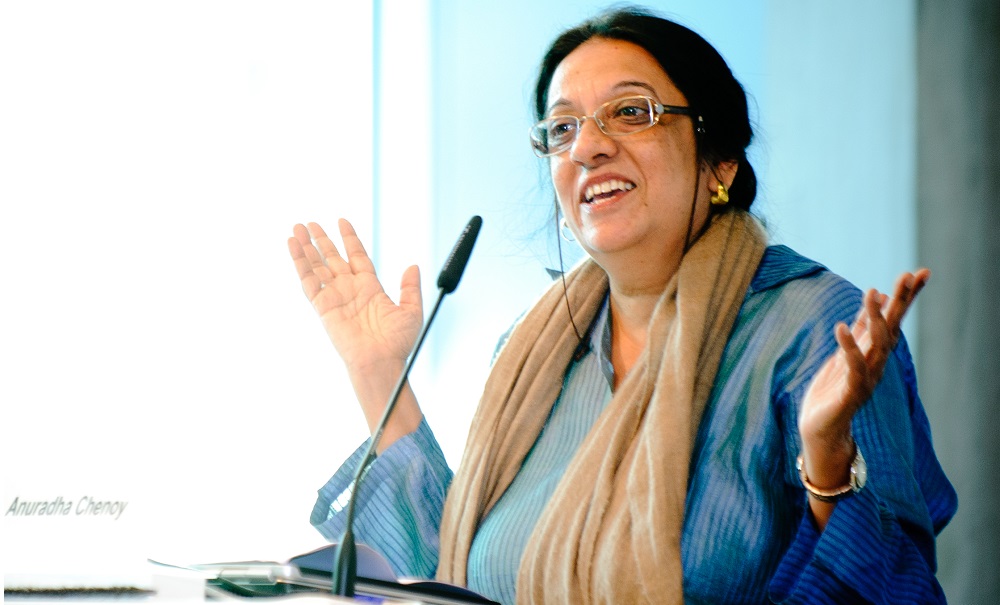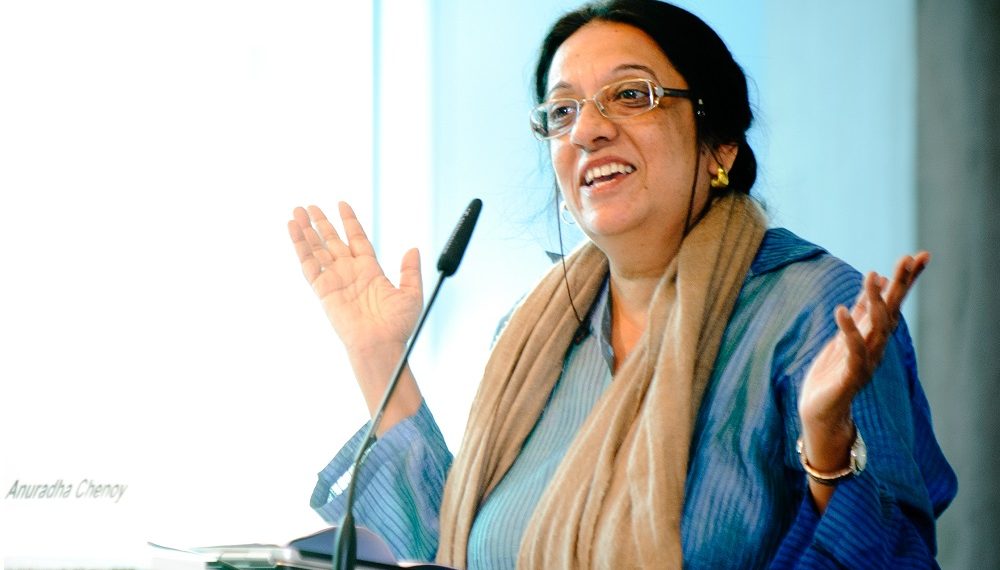How and Why Social Justice and Peace are interlinked
Anuradha Chenoy
(Former Professor and dean, School of International Studies, Jawaharlal Nehru University, New Delhi)

“Universal and lasting Peace can only be established if based on social justice”. (International Labour Organisation, Preamble, 1919)
There is reason to recall these words from the Constitution of the ILO a hundred years after its formation. The ILO’s Preamble in the Post World War I said this to underline the following: (a) The understanding of war as collective human tragedy, material and ecological waste. (b) Post war peace can only be sustained with social justice and as opposed to retribution, force and chauvinist identity nationalisms. (c) Cohesive societies can be based on social justice and affirmation of rights of labour and other communities. (d) There was a clear need to isolate and politically defeat the growing fascist right wing, and its support amongst the mass in the coming 1920s and 30s. (e) Need for multilateralism, collective security and strengthening the League of Nations (LoN) despite its inherent flaws.
This paper states that this goal of the ILO remains relevant. It makes an attempt to retrace some key characteristics that are re-visiting the 21st century neo liberal era. We also show the distinctions between these two periods and establish why social justice and peace are interlinked.
I. Weakened Based for Social Justice and Peace in the 1930’s
Contrary to the vision of the ILO, the 1920’s/30’s witnessed: (i) A rise of identity nationalisms, especially in Central East Europe, but also Italy and Japan. (ii) Increasing oligarchic control of banks and industrial production. (iii) Dispersed, disorganised labour (iv) Competitive nationalisms, privileging state security with simultaneous disregard by member states of multilateralism and ultimate disintegration of the LoN. (v) Rise of the xenophobic right and ultranationalist militarisms. (Italy, Germany, Japan) (vi) A shrinking and de-legitimisation of liberal ideas. (The policies of colonial imperialism, weakened liberal values) (Vii) The coalition of centre, liberals and conservatives fractured, as the far right grabbed power and exercised authoritarian control. (vii) The liberals and centrists did not take the right extremists seriously, used strategic appeasement, to further their own interests. The revolution in Russia was seen as a bigger threat than the rise of Nazi Germany. Gramsci wrote in the 1930’s: The political centre has lost its capacity of organising and guiding the proletariat (masses). In these circumstances the fascists were able to conduct coups and rule with extra legal (vigilante) organizations.
II Legacies of Post WW II and Links between Social Justice and Peace
The defeat of fascist forces in WW II (i) laid the foundation for liberal politics and state welfare policies that re-adjusted the dominant forms of finance capital. These helped to re-construct war torn societies. These could counter the ideas of the communist bloc on equity. (2) Liberal democratic states formed a hegemonic bloc/collaboration between the conservatives and liberals, based on a market economy, hawkish foreign policy, nuclear militarism. (3) Welfare policies/ social justice and civil rights, provided both legitimacy and material base to this social entente. Despite racisms, interventions and proxy wars in the new Third World. This Western entente provided the base for freedoms and strengthened the capitalist order. (4)The post WW II years saw peace in the West with Cold War, rise of US militarism, de-colonization, proxy and civil wars in the emerging Global South. (5) Internationally in the dominantly bipolar world and Cold war, it was still possible to develop multilateralism, in the form of and Bretton Wood institutions, provided international institutions that could be used for the expansion of capitalism. This was followed by a decade of de-colonisation, a north-south dialogue, and later the peaceful disintegration of the Soviet Union.
III The Rise of the Neo Right: Recalling the 1930’s?
Similarities of the 30’s and current Right Wing Populisms (RWPs)/ Populists authoritarianisms do have different contexts. Yet some broad echoes include some common characteristics: (1) Oligarchic control of finance capital on economic and political relations. (2) Economic crises of unemployment, austerity, informalization of labour in neo liberal practice. (3) The break in the consensus on constitutionalism between the liberals and conservatives hegemonic block. The conservatives have shifted to support of the right wing populists (RWP), even as they deny their own constitutions and usurp extra constitutional powers. (McDougal, 2019) (4) The strongest attack on liberal values and universal rights, social protection, since the 1930’s has re-occurred in this recent past. (5) The strong charismatic leader that directly represents ‘the will of the people’ that de-legitimises constitutional norms and allows the use of force on internal and external opposition. (6) The myths of national culture in decline even without evidence propagated as truths. (7) Geopolitics defined in terms of religious/racial civilizational war mostly framed as Islamophobia. (5) Fraying of multilateral institutions; decreased faith in collective and common security. (6) The coming apart of important treaties like the break in the INF, refusal to re-negotiate the START. (7) Regional alliances stagnating, or declining, for example: SAARC, AAU, EU, In Africa the “new nationalism”, -is without Pan-African dimension. (Shivji, 2019) Some of the RWP of Europe (Kotleba of Slovakia) want to withdraw from both EU and NATO.
IV Differences from the 1930’s
(1) Despite their electoral victories there is a sizeable opposition to RWPs within each state. Liberal, autonomous institutions have had a longer life, more resilience, broader support base, historical memory and greater capacity to resist the tactics of RWPs to target and infiltrate these institutions. But the resilience of liberal democratic and autonomous institutions depends on each countries’ history of nurturing institutions; its political culture, and collective resistance. For example, in the US media like the New York Times, Washington Post, CNN have not given in to the onslaught by the Trump administration. In India however, a larger section of the media has been complicit with the regime. In several countries students and liberals and progressive forces have developed methodologies of resistance. (India, Hong Kong etc). In yet other countries centrist liberals became more authoritarian (France).
(2) New threats differ from those in the 1930’s period. For example, from non-state actors; threats without borders like climate change, ecological decline, global warming; cyber security and technological threats. New wars are more regional conflicts as well as intra-state with spill over effects and sub nationalist conflicts. Of course militarism and militarization are old phenomenon, but they have taken on new directions. Technology has completely changed as has methods of communications.
(3) Global policy to address global issues from climate to peoples welfare, are questioned and blocked. But multilateralism has had longer life, more experience, and benefitted many regions.
(4) New geo politics with the rise of regional hegemons, with client and rogue actions are new challenges. Nuclear proliferation is a new and unaddressed danger.
(5)Most of RWP leadership is opposed to social justice measures, for example: Trump has been committed to destroying the medicare put in by Obama. Macron and others continue with austerity programmes despite popular resistance. India has cut funding for rights based schemes like the Rural Employment Guarantee Act (MNREGA), and others.
All these differences are marked differences from the 1930’s but the outcomes need to be assessed.
V The outcome of these policies
(I)The RWP leadership’s policies are based typically on neo liberal economic and neo realist foreign policy approaches, clothed in nationalist/nativist rhetoric that blame minority and demonised social groups. These policies have no real capacity or inclination to address inequality, insecurity or the anxieties of the multitude. The RWPs seek to replace one set of poor communities by others. For example, some RWP leaders make black/Hispanic/Islamic people targets in order to increase their standing among poor white masses. The new poor are the migrants, minorities and people who are different.
(2) The outcome is increase in anxiety, use surveillance, hollowing out participatory and institutional democracy, increasing social conflict, poisoned civil life and more.
(3)The outcome is false majoritarianism, fewer rights, new inequality and churning of elites.
VI Resistance
There is clear resistance internationally in countries (where dissent is recognised) to policies that impoverish people. There are multiple social and peace movements that challenge hegemonic discourses and argue instead for social justice and peace. In these circumstances the connection between social justice and peace is an important part of the alternative paradigm.
The opposition includes:
(1)social movements, women’s groups, ecological movements, civil society, minorities, excluded and liberals. The point is to collaborate with liberals on civil and political rights, on deepening democracy, saving institutions, understanding dissent. And to critique liberals on their alliance with neo liberals; with their willingness to live with ethnic based demographic change for the sake of more reform, etc.
(2) All political opposition to the far right.
(3) People led multilateralism; Social justice and social charter etc.
References
McDougal, James (2016) No, this isn’t the 1930’s-but yes, this is fascism. The Conversation, November 16, 2016, Oxford. Available at: http://theconversation.com/no-this-isnt-the-1930s-but-yes-this-is-fascism-68867



